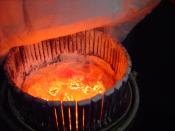This notion of controlling the public population is echoed in the play The Crucible directed by Micholas Hytner. The Crucible is a text which tells of power and how the powerful control the fragile, influential town of Salem. After a young girl Abigail and her friends were caught apparently 'dancing naked in the woods, the rumour of witches overwhelms the small town. The witch hunt was a perverse manifestation of the panic set in among all classes where, similar to Nineteen Eighty-Four, fear kept the masses controlled and ensured conformity. Authorities are brought in to purify the town, however true power does not reside with Reverend Hale or Judge Danforth. They have the power to send people to their deaths, but Abigail manipulates both themselves and their power so that the town conforms to their will. Power corrupts, and absolute power corrupts absolutely. Power existed remotely within authorities; they withheld knowledge from the town to guarantee conformity.
This technique highlights a lack of understanding and hegemony secures a society free from rebellion.
The scene where Tibuta, an African American slave is being tortured for a confession, is a didactic scene which demonstrates who holds the true power. Tituba is kicked to the ground but still claims she is "no witch". The camera angle shows the Reverend looking down at Tituba , which implies that power lies with him. However Tituba is shown staring up at Abigail, as does the audience, Tituba is aware of the truth and knows who holds the power. This scene portrays the powerful as innocent and as though actions are justified but conniving by nature. This scene also depicts the authorities physically exerting their power as a group over Tituba, but Abigail's manipulative and ultimate power is also implied.
The title The Crucible is...


